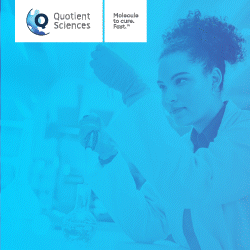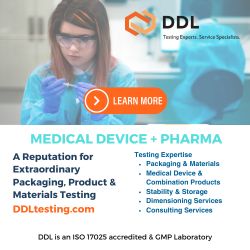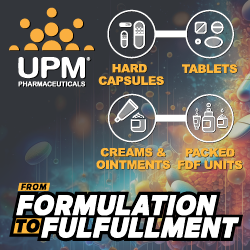Issue:January/February 2025
LEADERSHIP PANEL - What Will Have the Most Impact on Drug Development in 2025?
Optimistic. That is the word 75% of global life science leaders feel about the prospects for the industry in 2025, according to a new report from the Deloitte US Center for Health Solutions.1 This optimism is fueled by anticipated revenue increases, margin expansion, and advancements in technology that could lead to breakthrough innovation. This exclusive fourth annual Drug Development & Delivery Leadership Panel discussion asked life science leaders what they think will have the greatest impact on drug development in 2025.

The Rise of Oral Biologics
The rise of oral biologics, fueled by the desire for more convenient administration, marks a significant step towards patient-centric drug delivery. This trend promises to enhance patient adherence and improve outcomes, particularly for chronic conditions like oral Insulin or oral therapies with innovative biologic compounds for Inflammatory Bowel Disease and Rheumatoid Arthritis, driving significant interest and investment.
Focus on High Potency APIs (HPAPIs)
The increasing prevalence of HPAPIs necessitates specialized handling, expertise, and manufacturing capabilities. This trend reflects the industry’s focus on developing more targeted and effective therapies, often requiring smaller doses. Investing in HPAPI capabilities will be crucial for CDMOs and pharmaceutical companies to ensure the safe and efficient production of these advanced therapies.
Demand for Integrated Solutions
Pharmaceutical companies are increasingly seeking integrated solutions from their CDMO partners, streamlining operations and fostering greater efficiency through collaboration. This trend reflects a desire to reduce the number of suppliers and access comprehensive expertise from a single, trusted partner across the entire drug development lifecycle.

Development of Innovative Nasal Spray Device Technologies
These devices offer improved usability, dose accuracy, and portability, leading to user-friendly devices that are easy to handle and minimize discomfort. Although this can improve patient compliance, developers must carefully consider nasal spray device selection. This can influence product performance and the patient experience. By leveraging nasal spray development expertise, companies can optimize device design, formulation characteristics, and product performance.
Availability of Funding for Startups
There has been a decline in funding over the past few years, following an initial surge before that, and the market is now starting to recover. This means that startups must carefully consider budgets and spend wisely. Here, partnerships with CDMOs can provide a potential solution. Partnering with a CDMO from the early clinical phases of a project all the way to commercialization is a solid strategy for maximizing budget and ensuring product progression. Expert CDMOs should be capable of offering support from pre-formulation and formulation development to validation and regulatory support and everything in between.
Artificial Intelligence
AI and other technologies will continue revolutionizing drug development by expediting drug screening and optimizing early-stage research. These technologies can enable the analysis of vast datasets, identify promising candidates and predict treatment response, ultimately accelerating the delivery of life-changing therapies.

Security of Supply
The secure supply of critical materials for drug development, including chromatography resins, has become critical in the wake of global disruptions such as the COVID-19 pandemic and geopolitical tensions. To address this, suppliers are diversifying production capabilities by investing in dual-continent manufacturing and prioritizing local sourcing, mitigating supply disruptions.
Greener Biomanufacturing
Regulatory pressures and societal demands will continue to drive innovation in greener biomanufacturing processes, and, as an industry, we must prioritize resources that are vital for life. Technologies that reduce water and solvent use, cut carbon emissions, and extend the lifecycle of raw materials are becoming integral to achieving both operational savings and environmental stewardship.
Cost Optimization
Cost optimization is paramount as patents on blockbuster biologics expire, creating opportunities to broaden access to biosimilars. However, increasing competition and demands from payers for lower prices are putting pressure on manufacturers to reduce costs. Innovations such as high-performance resins that can support process intensification strategies can enhance efficiency, reduce production costs and support the sustainable production of affordable biosimilars. These advancements are essential for balancing competitiveness with the goal of improving global access to medicines.

Commercialization of Cell and Gene Therapies
While reduced investment in CGTs became a common theme in 2024, there have been encouraging signs with recent announcements that we could be turning a corner. While we understand that investors need to see promising clinical data before making decisions, clinical data can only be generated if investors take a chance on early-stage companies with promising candidates. We hope to see renewed investor confidence in the promise of CGTs in early development in 2025. We are likely to see an increased focus on improving patient access to CGTs. A key part of this will be to ease the administrative burden of ordering these advanced therapies. The sector should look to technologies that can streamline workflows, improve collaboration, while safeguarding patient data. There are a multitude of orchestration platforms (software that tracks, manages and coordinates patient journeys for CGTs) currently available. Healthcare professionals at busy treatment centers may have to interact with several of these during a working day. Inconsistencies between platforms can lead to ‘portal fatigue’ for users. Standardization across platforms will help ease this frustration and boost efficiencies for the successful delivery of CGTs to patients.

Expansion of the Advanced Therapeutic Medicinal Product
In 2025, we will see the expansion of the advanced therapeutic medicinal product (ATMP) sector, driven by the development of novel gene editing technologies. Gene editing can provide transformative treatments for various conditions by addressing diseases at the genetic level. However, as a new therapeutic space, gene editing presents challenges for developers, including a steep learning curve, unique manufacturing requirements and limited access to costly production technologies. Complex ATMPs and gene editing products can suffer from supply chain constraints, with developers often relying on multiple partners to source raw materials, reagents and equipment. All-in-one CDMO solutions can help transform how gene editing therapies are developed and manufactured, reducing complexity and accelerating time-to-market.
More Strategic CMDO Partnerships
Taking gene editing as an example, CDMOs that specialize in mRNA bioprocessing or LNP production could partner with a sgRNA specialist CDMO to provide a complete solution from the same facility. These partnerships benefit developers as they create a single contract for all activities, simplifying development and manufacturing.
Reference
- 2025 life sciences outlook, Deloitte Center for Health Solutions, Dec. 2024, https://www2.deloitte.com/us/en/insights/industry/health-care/life-sciences-and-health-care-industry-outlooks/2025-life-sciences-executive-outlook.html.
Total Page Views: 4255












